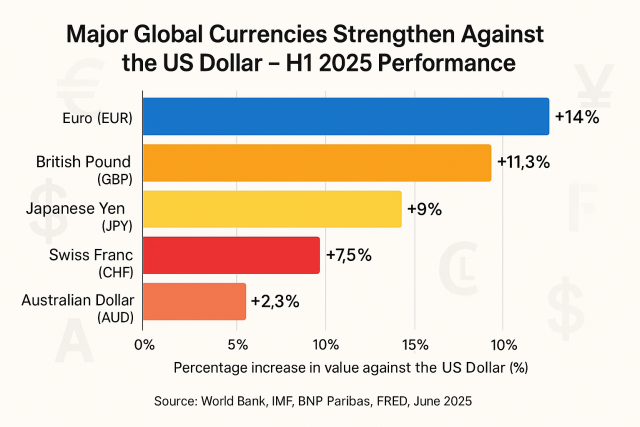International Desk:
In the first half of 2025, major global currencies have experienced an unprecedented surge against the US dollar. The beginning of President Donald Trump’s new term has been marked by unilateral trade policies, increased tariffs, and soaring public debt, which have collectively shaken investor confidence in the dollar. In this context, currencies such as the euro, pound, and yen are steadily gaining strength—indicating a significant shift in the global economic balance.
According to data from the World Bank, IMF, and leading economic research institutions, the euro (EUR), the official currency of the European Union, has appreciated by nearly 14 percent against the US dollar during the first half of the year. This steady rise, after a long period of stagnation, is being interpreted as a sign of policy and economic stability in Europe. Standard Chartered forecasts that the euro-dollar exchange rate may reach 1.20 by the end of 2025.
The British pound (GBP) has also strengthened by approximately 11.3 percent against the dollar. The UK’s political stability and a revitalized commercial sector are seen as key drivers behind this trend. Currently, the pound is trading between 1.35 and 1.37 dollars.
Japan’s yen (JPY), a key currency in Asia’s largest economies, has gained more than 9 percent against the dollar, although at a more moderate pace. The yen is now trading between 143 and 144 per dollar. Market analysts point to Federal Reserve policy uncertainties and Trump’s aggressive tariff regime as factors boosting investor interest in the yen.
The Chinese yuan (CNY) has remained relatively stable. Its current exchange rate ranges between 7.16 and 7.19 yuan per dollar. While the Chinese government maintains a firm grip on monetary policy, its export-driven strategy has also helped stabilize the yuan amid global turbulence.
Other strong currencies like the Australian dollar (AUD), Canadian dollar (CAD), and Swiss franc (CHF) have also appreciated against the dollar this year. Notably, the Swiss franc has reached its highest value in a decade.
Among emerging market currencies, the Indian rupee, Singapore dollar, and Indonesian rupiah have maintained relative stability. However, analysts suggest that the weakening dollar has indirectly enhanced their purchasing power.
Experts believe that the US dollar’s long-standing dominance in the global economy is now under scrutiny. Uncertainty over interest rate policy from the Federal Reserve, unilateral decisions by the Trump administration, and an erosion of trust in global trade dynamics are collectively signaling a structural shift in the currency landscape. Around the world, nations are now rethinking the risks and viability of relying solely on the dollar.











